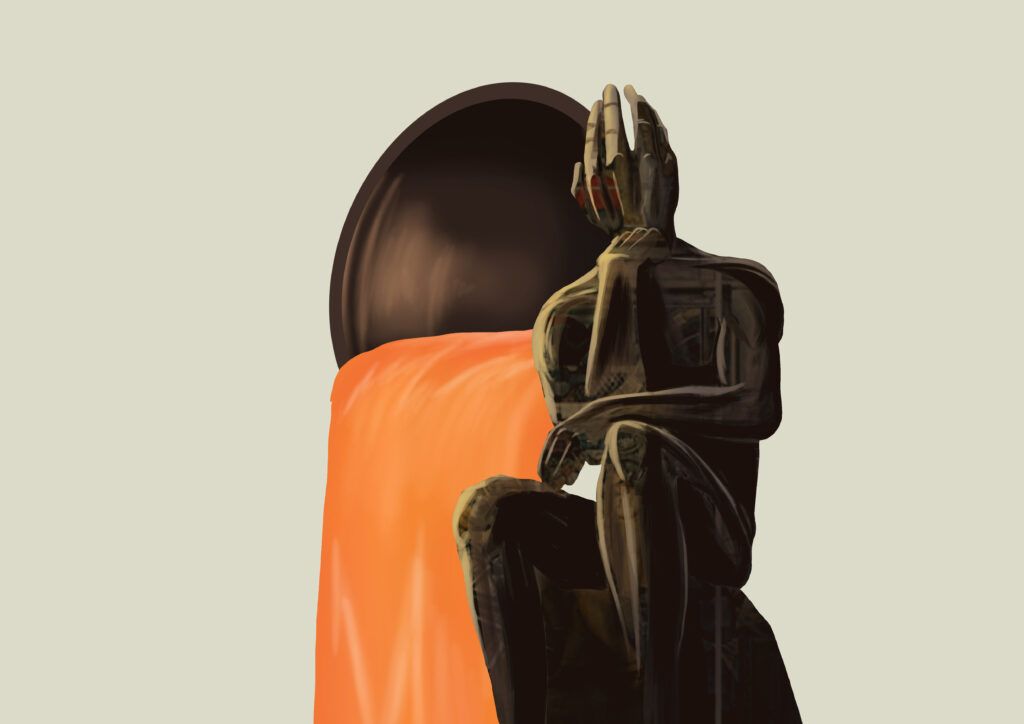I.
The sun shines on the Thinker, in the morning, outside the marble
museum, the Detroit Institute of Arts, the home of Diego Rivera’s
Detroit Industry Murals. A portrait of the automotive renaissance.
Inside the hundred galleries, twenty-seven frescoes cover the courtyard
walls where there once was a cafe. Ghosts of dead cigarettes still stain
walls and give the hall a nicotine patina.
Rivera followed Kahlo and the couple spent a couple
of years in the industrial capital. Days after the Battle of the Overpass,
Rivera began to paint the city hit hardest by the Great Depression.
Entering the museum, you walk east, into the glass ceiling solarium.
A baby in a bulb begins life, with two mothers and two cornucopias.
The baby has not opened his eyes, he has not seen the sun rise.
II.
On the north wall, a motor is being conceived, with little ease,
as hundreds of men make molds with molten steel
and manufacture a motor, accurately rendered in paint.
Above the overalls and hats, vats of flaming liquid light
the factory and the furnaces makes men kin with Dante.
There’s no polished way to paint sweat.
River Rouge is a constant enterprise, with prizes for only few
who do not work for low wages in Ford’s Factory. The belly of the plant
shows the darkness of demand for cars from the Motor City.
The conveyor belts contour like a labyrinth around the assembly line.
Their tasks seem sisyphean although a finished V-8 is their final
project. A Detroit proud product, Ford’s first home.
III.
Los manos de Rivera pintaron humanos. Red hands holding iron,
Black hands holding diamonds, white hands holding limestone, yellow
hands with sand. The raw materials of a car in the grip of Detroit’s diversity.
Here they assemble the body, using their bodies to make the cars that
made the city. Here Rivera welded the workers into the fabric of the city.
He captured the conditions of the factory and made their story epic.
A stamping press is the serpent-skirt Coatlicue, an Aztec goddess that was fed
human hearts in order to maintain order of the universe. Who maintained
the order of the factory? What sacrifices did the workers make?
The south-side wall is driving toward the future and most Detroit factories
sit still today. Rivera saw the grand vision of capitalism and layered it into
his art. His heart was with the people, like the people painted in the middle of mural.
IV.
Walking down Woodward, past Cass corridor, through doors of DIA, I see these
walls as the center of Midtown Motown. Rivera’s four walls are a metaphor for
the house that Ford built. Henry’s idea was the line, the workers wrote the poem.
My relatives screwed in the wheel at the Packard Plant. They saw the automotive
industry as golden. That was before, when they were in Poland. In Hamtramck
they panicked but still made pączki to make themselves still feel Kraków.
The artist from Guanajuato stayed two years to paint pistons and general motors.
Above the latin-etched vita brevis ars longa, he filled the west-wall with a final fresco
depicting the culmination of construction and destruction of capitalism.
The hawk yawps at the dove, passenger planes and bombers pass by. Fish and fishers
share the Detroit River nearby. Every year classic cars drive by during the Dream Cruise.
The Industry Murals share a beat of Detroit’s history, more is across the street in the library.
The Spirit of Detroit

Illustration by Allen B. Thangkhiew
Posted On: June 5, 2025
